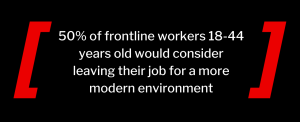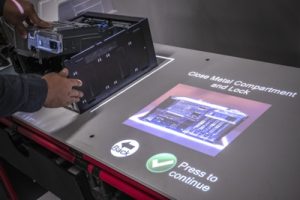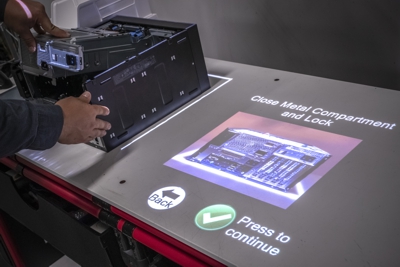By the end of 2021, nearly every industry across the U.S. felt the effects of the Great Resignation, including manufacturing. At the end of November, 420,000 manufacturers had quit, were laid-off or discharged, or otherwise separated from their position. These separations increased by about 14% from 2020 to 2021, with voluntary quitting rising from 64% to 70%.
With such staggering numbers, it’s no wonder businesses have been searching for new ways to recruit and retain workers. Luckily, rising technologies are offering promising solutions to the challenges manufacturers face as a result of the Great Resignation and the growing skills gap.
Read on to learn how digital transformation is accelerating the recruiting process, and discover one digital tool that’s helping leading manufacturers train and retain workers.

What Is the Great Resignation?
The Great Resignation is more than people quitting their jobs. It’s an accumulation of changing preferences and expectations inside and outside of work.
Remote work led many people to spend more time considering their wants and needs. New thoughts about work-life balance, work-from-anywhere environments, sustainability, and personal goals are gaining more importance. This has led some to make career changes that better fit their values.
Beyond changing values, the last few years held many people back from making bold career changes. Between the pandemic, workplace structure changes, and the new roles workers took on, job security really was just that—security. The overwhelming changes in people’s lives kept them from making adjustments they might have made under normal times. Now that people are more comfortable in this new, dynamic environment, making career changes is back to being an option.
Changing Careers: Training, Upskilling, and Retirement
It is well known—and was even before the Great Resignation—that droves of experienced workers are approaching their age of retirement. A survey by the Federal Reserve Bank of New York (referenced by Ben Winck in Business Insider) actually found that the “average…adult [that] expects to work beyond 62 is 50.1%.” While the age range of people working in the manufacturing industry is decreasing, at the end of 2020 about a quarter of manufacturing workers were still 55+. In addition, buyout packages, health concerns, or new lifestyle changes have amplified this need to move forward. The average retirement age is now occurring earlier than ever.
As experienced workers retire, new workers are brought in that require more time and training to integrate into operations. There is a skills gap, as these new workers don’t have the deep tribal knowledge carried by their predecessors. Plus, training is more difficult because there seems to be less time to train workers and fewer personnel to perform the training. Short-term career options are preferable by younger generations, specifically millennials and Gen Z. It’s not uncommon for these workers to stay in a position for 3 to 5 years rather than the 20+ years of their peers from previous generations.
Along with career preferences, such as shorter job terms, younger workers, in particular, used the pandemic to prioritize their work needs. By spending more time thinking about what they do want out of a job, it makes it easier to rule out what they don’t want. And if they don’t see what they want where they’re at, they try to find it somewhere else.
So, if experienced workers are leaving the workforce, how do we shift our focus to retain younger workers? How do we figure out what will keep them?
RELATED: Closing the Skills Gap
Solutions to the Great Resignation in Manufacturing
In a survey of over 1,000 frontline, non-managerial manufacturers, there was one overarching reason that would make younger workers stay in their job. The best part? It’s also a solution to many other modern operational challenges: digital transformation.
“The State of Digital and Connected Work on the Manufacturing Frontlines” report asked frontline workers of all ages what would affect their consideration to leave their current position. Their top answer: A modern work environment.

Of those asked, 50% of frontline workers 18-44 years old would consider leaving their job for a more modern environment. And surprisingly, even 25% of respondents over 55 said it would also play a factor in their consideration to leave their job.
In a study of over 12,000 Gen Z students, Dell Technologies found that 80% aspire to work with cutting-edge technology, and 91% state that their job choice is influenced by technology.
But what does a modern manufacturing work environment mean? Here’s a look at the integrations workers would like to see.
Digital Work Instructions in Manufacturing
Most manufacturing workers surveyed (81%) reported they still rely on paper for work instructions and to track work. This statistic shows a clear opportunity for manufacturers to leverage digital technologies to empower their frontline workforce.
Let’s be honest, paper work instructions are outdated. Literally and figuratively. As soon as data is printed on paper, it is no longer dynamic and—in a way—dies. It takes a lot of time and motivation to update the information and redistribute it. Ultimately, it is a begrudging task that many people avoid and sometimes don’t complete at all. Then, not only is the data and method of guidance dying, business agility is as well.
Additionally, writing work instructions isn’t an easy task. There is still a time investment. But it is much faster to implement digital tools that automatically update work instructions across the plant, rather than individually deploying reams of paper to every workstation.

LightGuide Projected Augmented Reality Use Case
RELATED: 6 Tips for Writing Practical Work Instructions
Digital work instruction tools offer simple, easy-to-follow guidance that puts information right where the worker wants it. Additionally, digital guidance tools show workers the innovations the company invests in to make their work better, proving the company values them.
Proficiency and Upskilling in Manufacturing
As part of the dynamics of our new world, younger generations are used to looking for and receiving information extremely fast. Due to this, they are also used to ingesting information at a rapid rate and acting on it immediately. This immediate action overflows into the development of skills and many people assume—and expect—they’ll reach proficiency in skills faster.
However, everyone learns at a different pace. So, how do you quickly and efficiently train a whole new group of workers? And on top of that, how do you help them reach proficiency quickly without high rates of turnover?
Guidance verification, usually within guided work instruction systems, is an immediate way to test and train manufacturing workers on the job. Systems like LightGuide’s Projected Augmented Reality (AR) Platform use a combination of 3D vision cameras and projected visual cues to guide and confirm the exact placements of parts for workers. This kind of verification provides double coverage, working in training modes to quickly bring new workers up to speed and in production, ensuring zero errors by not moving forward if the step was completed incorrectly.
Beyond verification, LightGuide’s enterprise-ready software makes it easy to select from a variety of different programs running at the same workstation. This makes it possible to train a worker in multiple skills on multiple products or upskill a worker, at any time with little to no decrease in efficiency by training them on the best practices from the first cycles they run.
RELATED: How to Use Augmented Reality to Upskill Workers
Some large organizations, like a leading aerospace company located in Pontiac, MI, enable six-month rotational programs for their younger staff. These programs give them a well-rounded skill set, a sense of upward mobility, and retain them longer if they aren’t satisfied in their current role.
As 68% of younger workers reported in “The State of Digital and Connected Work on the Manufacturing Frontlines,” they would be ready to move on to another position in the next five years. Therefore, it is critical that we prioritize upskilling workers. The variation of work provided through new training increases worker engagement and retention and proves the worker is valued.
Embracing Digital Transformation to Counter the Great Resignation
Modern manufacturing companies that embrace digital transformation will continue to retain workers and maintain a competitive advantage, effectively countering the impact of the Great Resignation. As the research shows, it will require some short-term sacrifices—removing old ways of operating to make room for agility—to create long-term, sustainable benefits. It’s clear that frontline workers expect the advantages of a modern, digitally-connected world, inside and outside of work.
LightGuide CEO Paul Ryznar summarizes the road ahead, stating “To counter the Great Resignation in manufacturing, we need to modernize our factories by digitizing them with technologies that allow the physical process twin on a factory floor to match the digital twin. By providing the workforce with guided workflows, amazing results become possible through increased worker proficiency and the ability to quickly upskill manufacturing teams.”
To learn more about connecting workers to modern manufacturing environments, reach out to the LightGuide team to discuss how you can harness the power of projected augmented reality (AR) guidance in your factory of the future.


